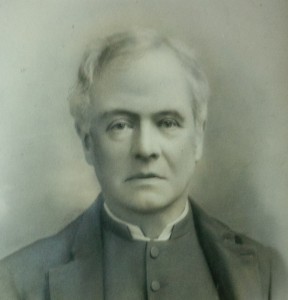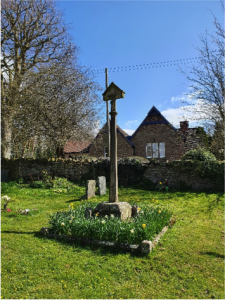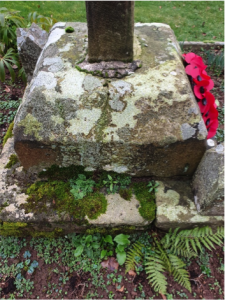It is hoped that three things here will be of significant help to those interested in the history of the Church:
a) The Visitor leaflet
b) An account of the tenure of The Revd Edward Palin as vicar at St Mary’s from 1865 – 1903
c) A description of the Churchyard Cross and war memorial-
For information about the Ancient Yew trees in the Churchyard please go to the Linton Clubs and Societies Tab and click on FoLY.
A number of the tombs and gravestones have Grade II listings. Listed Buildings at St Mary’s, Linton Click here for a listings of these. Further information on the graves and memorials can be found on the Family History Tab.
Those who would like more information are invited to contact a member of the Parochial Church Council (see ‘contact St Mary’s).
THE VISITOR LEAFLET
We hope that the leaflet provided to welcome visitors will provide a useful introduction to the Church.
Visitor leaflet July 2015 final
THE REVEREND EDWARD PALIN

The Induction of The Revd Edward Palin as Vicar of Linton on 19th December 1865 was commemorated 150 years later to the day in a Ceremony in St Mary’s. He was vicar here for 38 years and was responsible for transforming the life of the people in the Village. An account of his tenure throws light on conditions at the time and the huge benefits which he brought to the village and its inhabitants follows here:
EDWARD PALIN leaflet final version
THE CHURCHYARD “CROSS OF SACRIFICE”
A description of the old preaching cross in St. Mary’s churchyard appears in the national survey of ancient monuments conducted in the early 1930s. The entry, published in ‘An Inventory of the Historical Monuments in Herefordshire, Volume 2, East’ (HMSO), reads: “Churchyard Cross: S.W. of church—square chamfered base on square step, mediæval, shaft modern.”
This short summary hides a fascinating history. As correctly identified, the chamfered base is medieval. It has been constructed using irregular blocks of local Forest of Dean Pennant sandstone. The base originally formed part of a cross. It’s age is not known but it could date back to late Saxon times. Some of the early Christian monuments reused prehistoric standing stones but in this case the material may well have been brought from a feature discovered at the site of the British-Romano settlement of Ariconium. The tufa used in the the north arcade of St. Mary’s is also thought to have come from Ariconium. No documents exist from the Dark Ages, but the Domesday Book confirms the importance of Linton (or Lintune) during the early Anglo-Saxon period which saw the introduction of Christianity to Herefordshire.
Many of the earliest standing crosses in England were erected as preaching crosses, marking where the common people would gather to hear sermons and proclamations. Most were initially of wood, later replaced by stone. The tradition of constructing stone crosses as both memorials and to mark open air places of worship continued through the early medieval period. A statute issued by Edward I in 1285 stated that the erection of a cross was a form of legal consecration of the spot. The simplicity of the Linton churchyard cross base, and the early Anglo-Saxon origins of St. Mary’s, suggest it is very old. Notably, it lacks the pronounced stepped base which evolved in the late medieval period. It seems highly likely that the Linton residents of the time heard about the battles of Hastings and Agincourt at the preaching cross and later generations were, without doubt, informed of the defeat of the Spanish Armada.
In the C17th, the original churchyard cross could never have survived the success of Parliament against the King in the English Civil War and the rise of puritanism. Across England, preaching crosses endured a religious ‘vandalism’. Many would stand for centuries as a stone base with only part of a shattered shaft visible and no adorning cross. The preaching cross in Linton churchyard shared this fate.
For some 250 years, the base of the former cross lay forlorn in the churchyard. The only change in the immediate vicinity was the building of a new village school on adjoining glebe land in 1871 followed closely by Edward Palin’s revamping of the church in 1875-6. Then came 1914 and the outbreak of World War One. Some 750,000 British soldiers were tragically killed including ten young men who had lived in the Linton area. To commemorate the war dead, the Cenotaph was revealed in Whitehall in July 1919. Originally, built of plaster and wood, it was by public demand converted into a stone structure as a permanent national memorial. There was also a call for every community to have its own memorial such was the scale of sacrifice during the war. In Linton, the local War Committee chaired by vicar George Box, raised funds by public subscription to build a village war memorial. Bearing in mind that Linton was an impoverished agricultural community it must have been difficult for many local families to donate money, but they did.
The Royal Academy decided that “the most satisfactory way of guiding promoters of Memorials in the choice of suitable designs would be to hold an Exhibition of approved designs”. This ran from October 1919 until November 1920. Linton’s committee members decided to follow a common template with the names of the war dead displayed on a plaque inside the church. The plaque in St. Mary’s is brass while elsewhere they are mainly of marble (Aston Ingham, Upton Bishop, Much Marcle et al). Monies raised also enabled the old preaching cross in Linton churchyard to be restored with a new stone shaft mounted by a cross of Calvary. This was Linton’s ‘Cross of Sacrifice’ – now a feature of all the WW1 and WW2 cemeteries maintained by the Imperial (later Commonwealth) War Grave Commission. No names of the war dead ever appear on a ‘Cross of Sacrifice’.
Linton’s new war memorial plaque and restored cross were finished in time for the Remembrance Day service held on Thursday, 11th November 1920.
Today, Linton’s ‘Cross of Sacrifice’ is a grade II listed monument protected by law. After a century in its latest guise, it is now in a sad state of repair and in need of urgent renovation.
ROGER DAVIES
14/4/20


